维多利亚和阿尔伯特博物馆邓迪分馆,苏格兰,英国
建筑设计:隈研吾建筑都市设计事务所

图1 外景/Exterior view
“对于我们来说,这个项目的独特之处在于它的位置——坐落在水与城市之间。正因为其独特的位置,它有别于常见的项目场地。在我们开始思考该项目时,一位同事给我看了一张苏格兰东北部的悬崖照片:看起来就像是泥土和水进行了一段漫长的对话,最终形成了这种惊人的形状。维多利亚和阿尔伯特博物馆邓迪分馆的设计试图通过打造一座人工悬崖将这种地理独特性转译到建筑当中。”
——隈研吾,维多利亚和阿尔伯特博物馆邓迪分馆建筑师
环境
这座建筑位于邓迪昔日繁忙的海滨基础设施用地——已拆除的格雷伯爵码头遗址。它醒目的形式重新连接了邓迪的中心地带与泰河,呼应着那造船及纺织品贸易还是其经济命脉的时代。
形式
博物馆的形式灵感来源于苏格兰东北海岸线上的悬崖及其覆盖层。预制混凝土戏剧性的线条沿着弯曲的混凝土墙横向延伸,由此产生的阴影图案可随着天气以及一天中不同的时间而变化。
维多利亚和阿尔伯特博物馆邓迪分馆的外观犹如两座倒置的金字塔,于底层相互分开,却又在上部画廊层缠绕相连。这样一来,博物馆的中心不仅变出了一座开放的拱门——重新连接了城市与河流,更为泰河增添了一抹风景。同时,拱门的设计还参考了附近具有纪念意义的“皇家拱门”——于1844年为迎接维多利亚女王和阿尔伯特王子到访而建。
结构
隈研吾雄心勃勃的设计需要诸多工程师和施工人员的配合。这是一种独特而复杂的结构,外墙纵横缠绕,打造出类似波浪或船身的形状。
工程师原本计划在60cm 厚的墙里嵌入巨大的钢板,但在团队利用3D 模型和分析工具对建筑形状进行实验后,他们决定将墙体的厚度削减一半,并用更薄的钢筋替换其内部的钢骨架。
整个建筑的集成3D 模型被视为一种协调工具,让参与施工的建筑师、工程师和承包商可以将所要建造的结构数字化。
完工后的结构真实呈现了让其一举夺冠的卓越设计——屋顶最大的悬挑远远超出博物馆自身的占地面积,长达惊人的19.8m。
空间
维多利亚和阿尔伯特博物馆邓迪分馆的建筑面积为8445m2,包括主大厅、学习中心、礼堂、展览馆和永久的苏格兰设计画廊。建筑的底层分为独立两块,但在上方第二层相连。
该博物馆拥有苏格兰最大的博物馆标准式临时展览空间,面积达1100m2,另有550m2的苏格兰设计画廊。
施工过程
在施工初期,一块由12,500t 石头建成的临时围堰于2015 年5 月完工,为整个施工过程保驾护航;于2017 年夏天被拆除,标志着博物馆施工的最后阶段正式开始。
在完成地基后,两个独立的核心筒开始施工。内墙可从该核心筒一直延伸至建筑的周边,以支撑向外倾斜的外墙。
接下来是混凝土外墙的浇筑过程,一片巨大的临时结构网被搭建出来以配合整个过程。
这种结构由模板和脚手架组成。模板充当着一种模具,供浇筑的混凝土干燥与硬化,而脚手架则支撑着日渐成型的建筑。
数控机器通过三维模型的信息来切割模板。这一临时结构由一支20 人的设计团队完成,并在5个不同的地方进行加工制造。在工地现场,有多达30 位木工参与了该结构的制作,而场外的木工则超过了50 人。
当2429 块预制混凝土板都被吊起到位时,建筑的外部工程竣工了。这些建筑周围的混凝土板大小、形状和位置均各不相同,随着太阳光线在博物馆周围的移动而产生不断变化的阴影图案。
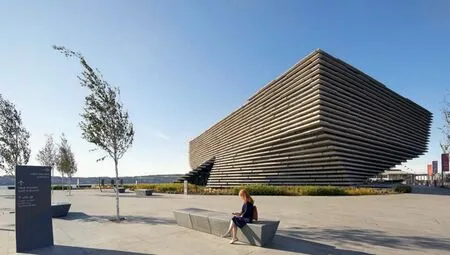
图2 外景/Exterior view
2
每块混凝土板重达2t、长达4m,是用角铁安装在预先浇筑于外墙上的凹槽而固定在建筑物上的。吊装和固定所有预制混凝土板的过程大约耗时7 个月。□(王单单 译)
项目信息/Credits and Data
地点/Location: 1 Riverside Esplanade, Dundee, DD1 4EZ,Scotland, UK
客户/Client: Dundee City Council
客户项目经理/Project Manager: Turner & Townsend
总承包商/Main Contractor: BAM Construct UK
主持建筑师/Lead Architect: Kengo Kuma & Associates
合伙负责人/Partners in Charge: Kengo Kuma, Yuki Ikeguchi, Teppei Fujiwara
项目建筑师/Project Architect: Maurizio Mucciola
项目经理/Project Manager: John Tavendale, Turner &Townsend
交付建筑师/Delivery Architect: PiM.studio Architects
执行建筑师/Executive Architect: James F Stephen Architects
结构/海事及土木工程设计/Structural/Maritime and Civil Engineer: Arup
机电消防声学工程设计/Mechanical, Electrical, Fire and Acoustic Engineer: Arup
外立面工程设计/Façade Engineering: Arup
照明设计/Lighting: Arup
景观建筑设计/Landscape Architect: Optimised Environments(OPEN)
工程造价测算/Quantity Surveyor: CBA
标识系统设计/Wayfinding and Signage: Cartlidge Levene
主持设计/Principal Designer: Kengo Kuma & Associates/PiM.studio Architects
主持设计顾问/Principal Designer Advisor: C-MIST
无障碍设计咨询/DDA Consultants: C-MIST – James F Stephen Architects
水景专家/Water Feature Specialist: Fountains Direct
餐饮及商业设计/Café, Restaurant and Retail Design:Lumsden Design
基地面积/Site Area: approx.11,600 m2
总建筑面积/Total Floor Area: 8445 m2
预算/Budget: 80.11M GBP
绘图/Drawings: Kengo Kuma & Associates
摄影/Photos: Hufton+Crow (fig.1-3,6-9,12-16), Ross Fraser McLean (fig.19-22)

图3 夜景/Night view
"The uniqueness of this project for us is in the position between the water and the city – it is very different from a normal site as it sits in between land and water. As we started thinking about the project, one of my colleagues showed me a picture of the cliffs of north-eastern Scotland – it's as if the earth and water had a long conversation and finally created this stunning shape. The design of V&A Dundee attempts to translate this geographical uniqueness into the building by creating an artificial cliff."
– Kengo Kuma, architect of V&A Dundee
Setting
The building is positioned at the heart of what was once Dundee's bustling maritime infrastructure,on the site of the demolished Earl Grey Dock. Its striking form reconnects the heart of Dundee to the Tay, echoing the time when shipbuilding and the trade in textiles were its economic lifeblood.
Form
The form of the museum is inspired by the cliffs on Scotland's north-eastern coastline, with the cladding – dramatic lines of pre-cast concrete that run horizontally around the curving concrete walls –creating patterns of shadows which change with the weather and the time of day.
V&A Dundee's appearance is of two inverted pyramids which are separate at ground floor, and then twist to connect at the upper galleries floor.This creates an open archway through the centre of the museum, reconnecting the city with the river,framing the view of the River Tay, and referencing the commemorative Royal Arch which was built nearby to welcome Queen Victoria and Prince Albert to the city in 1844.
Structure
Kengo Kuma's ambitious design demanded much of both engineers and constructors. It is a unique and complex structure with exterior walls which twist both horizontally and vertically, creating shapes like waves or the hull of a ship.
The original plans devised by the engineers included walls up to 60 cm thick with huge pieces of steel embedded inside. By experimenting with the shape of the building using 3D models and analysis tools, the team cut the thickness of the walls by half and replaced the steel skeleton inside with much thinner reinforced bars.
An integrated 3D model of the entire building was created as a coordination tool, meaning the architects, engineers and contractors involved in the construction could all study a digital version of what they were about to build.
The finished structure remains true to the extraordinary design that won the competition, with the largest overhang seeing the roof extend an impressive 19.8 m beyond the footprint of the museum.

图4 立面/Elevations

图5 剖面/Sections
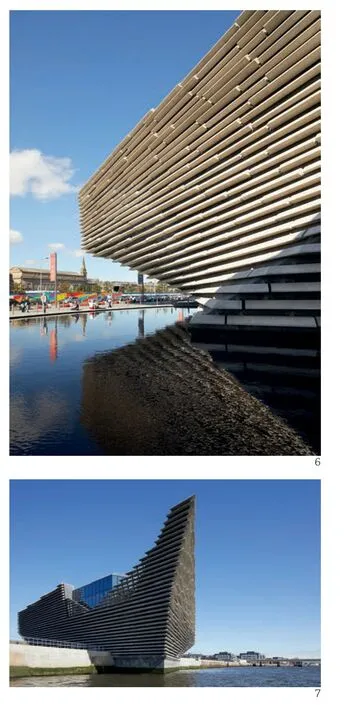
图6 .图7 外景/Exterior views
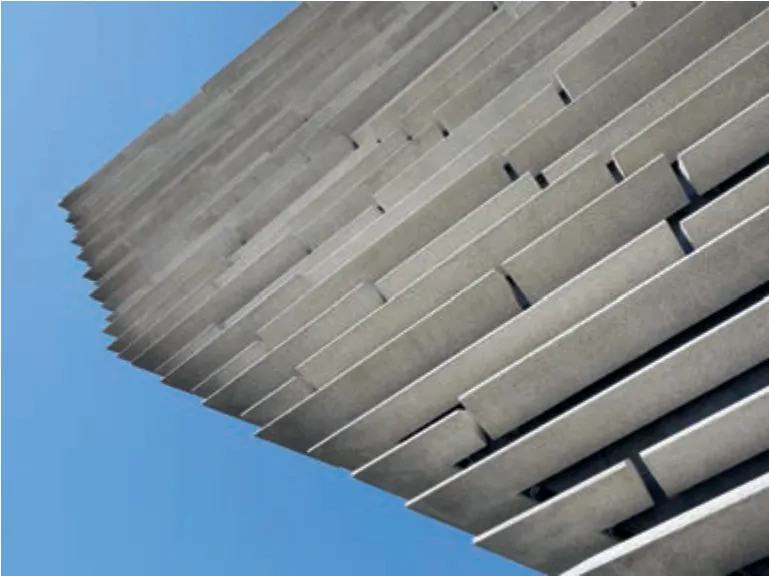
图8 局部/Detailed view

图9 外景/Exterior view
Spaces
V&A Dundee has a floor area of 8445 m2and includes a main hall, learning centre, auditorium,exhibition galleries and the permanent Scottish Design Galleries. At the ground floor level, it is arranged as two separate buildings. These join together on the upper second floor.
V&A Dundee has the largest museum-standard temporary exhibition space in Scotland, at 1100 m2,in addition to the Scottish Design Galleries at 550 m2.
Construction Process
At the start of construction, a temporary cofferdam, made from 12,500 tonnes of stone. The cofferdam was completed in May 2015 and was in place throughout the build. It was removed in the summer of 2017, marking the start of the last phase of the museum's construction.
With the installation of the foundation, two separate cores could be built. From these cores,interior walls reaching out to the perimeter of the building – designed to support the outward leaning exterior walls – were erected.
Next came the process of pouring the concrete exterior walls. To do this a huge web of temporary structure was created.
This structure comprised of formwork, acting as a mould in which the poured concrete could dry and harden, and falsework, which supported the emerging building.
The formwork was cut by digitally controlled machines, using information from the 3D model. A design team of 20 people worked on this temporary structure, which was manufactured in five different locations. Off-site, more than 50 joiners were involved in its fabrication, while another 30 were located on-site.
The exterior of the building was completed when all the 2429 pre-cast concrete panels were lifted into place. The size, shape and placement of these vary around the building, creating changing patterns of shadows as the sun moves around the museum.
Each panel, weighing up to two tonnes and measuring up to four metres in length, was attached to the building using brackets fixed into channels which had been cast, in advance, into the exterior walls. The process of lifting and fixing all of the pre-cast concrete panels into place took around 7 months to complete.□

图10 总平面-首层平面/Site-Ground floor plan
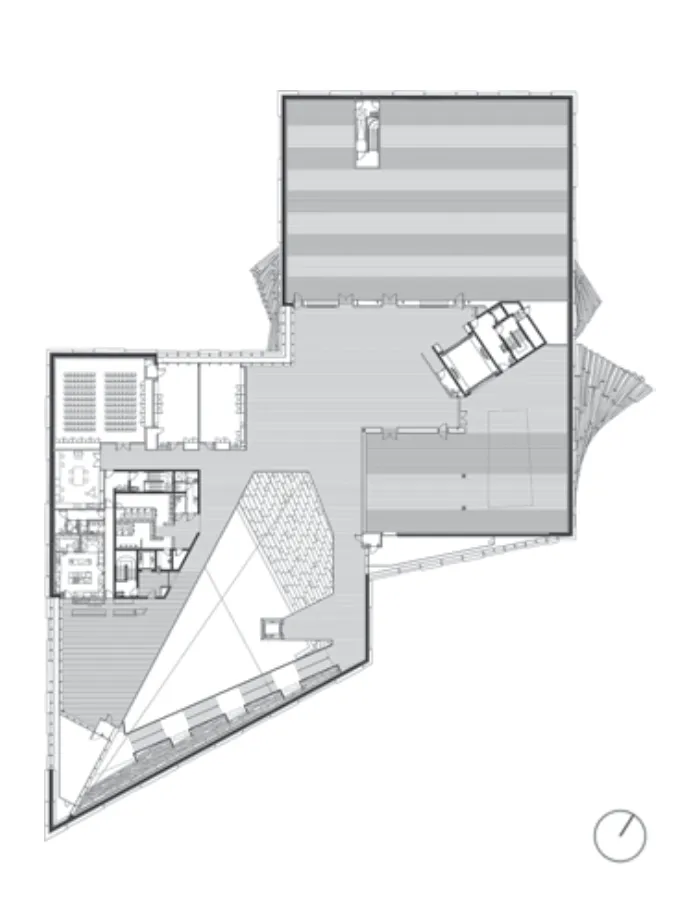
图11 展馆平面/Galleries floor plan

图12 .图13 内景/Interior views

图14 -16 外景/Exterior views
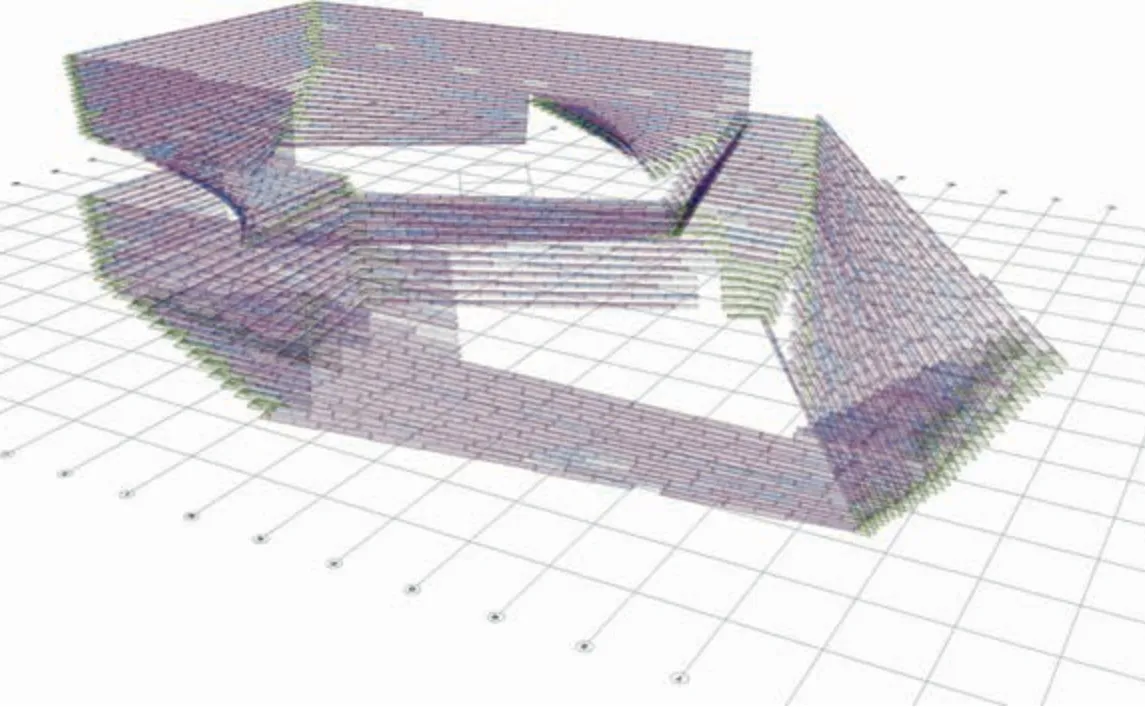
图17 外立面参数化模型/External façade parametric model

图18 外墙细部/External wall detail

图19 -22 施工过程/Construction process

